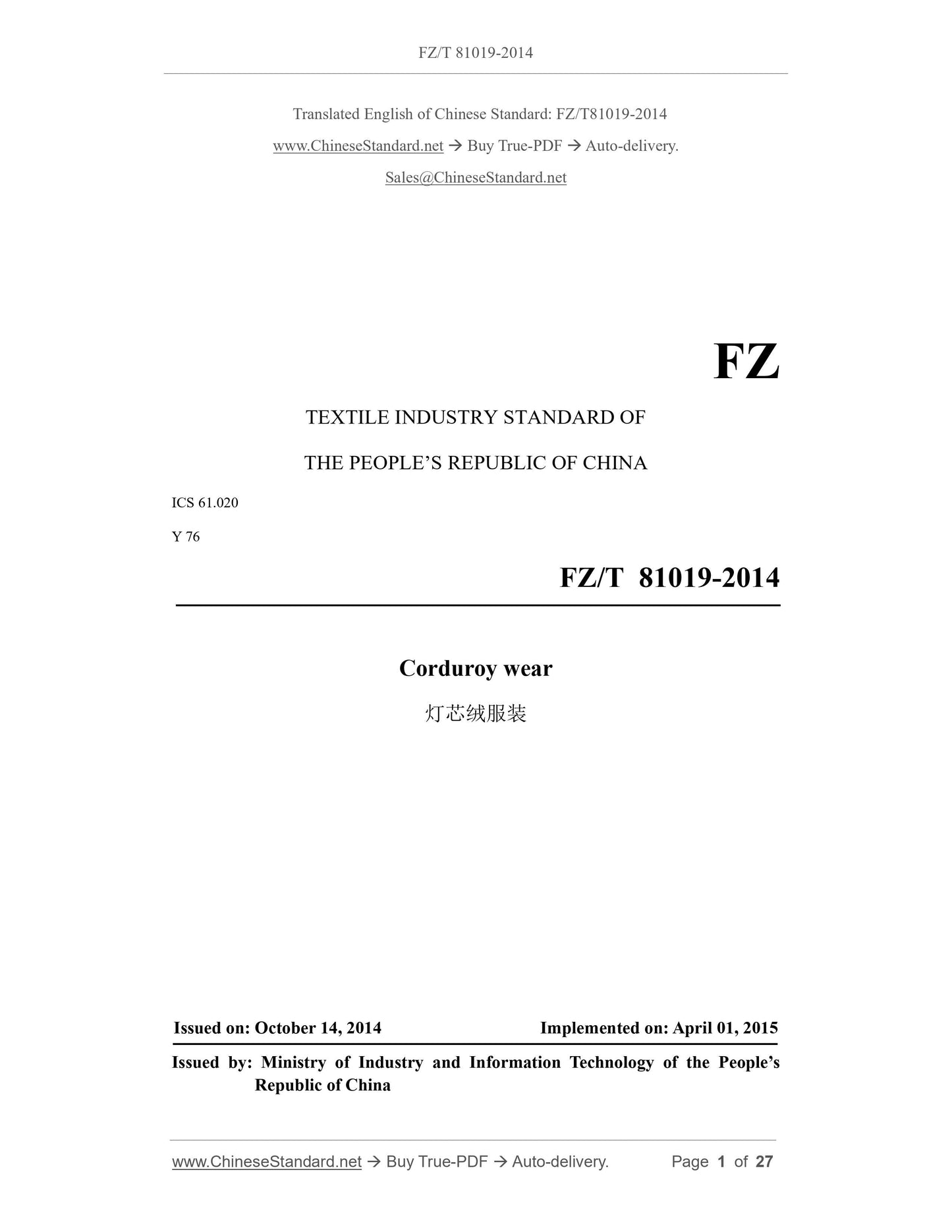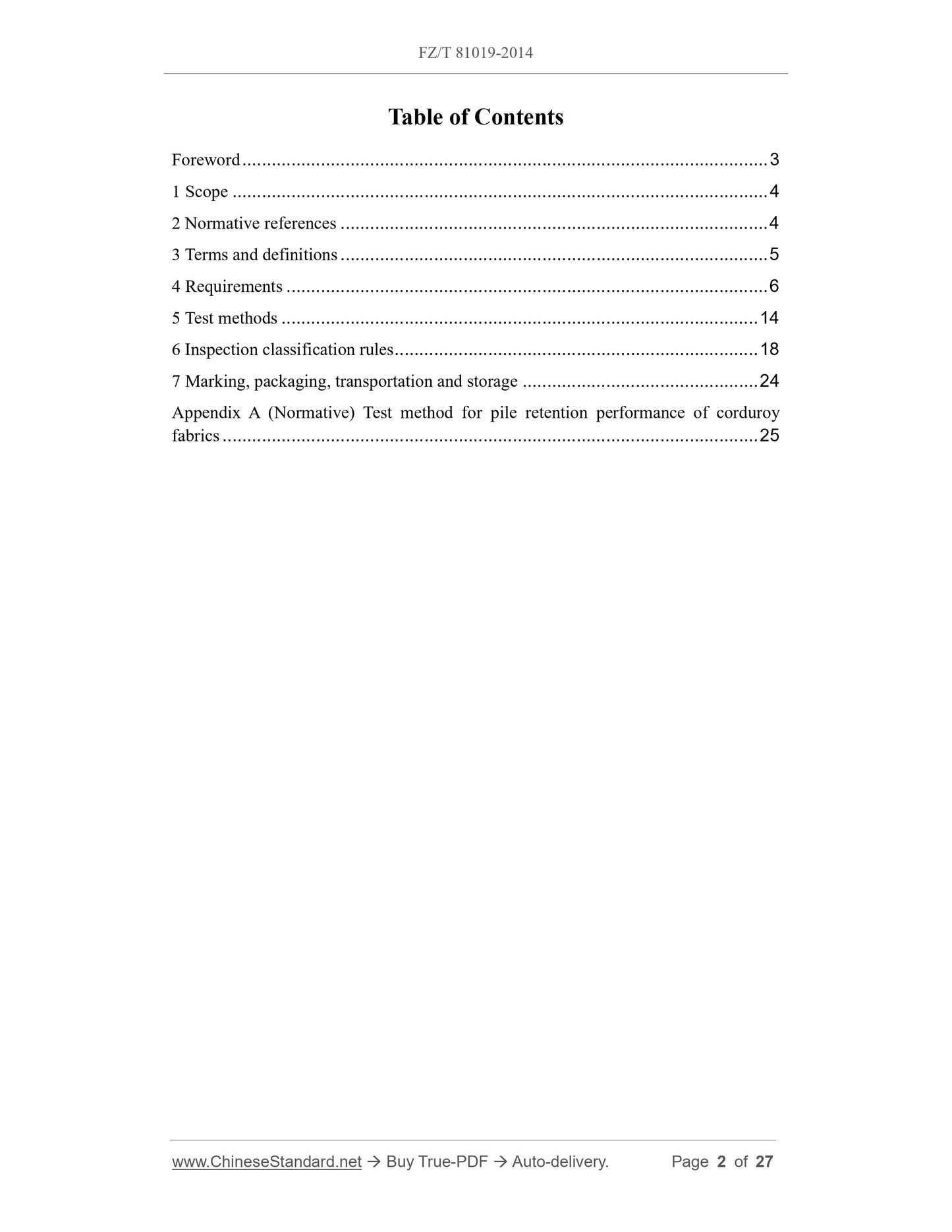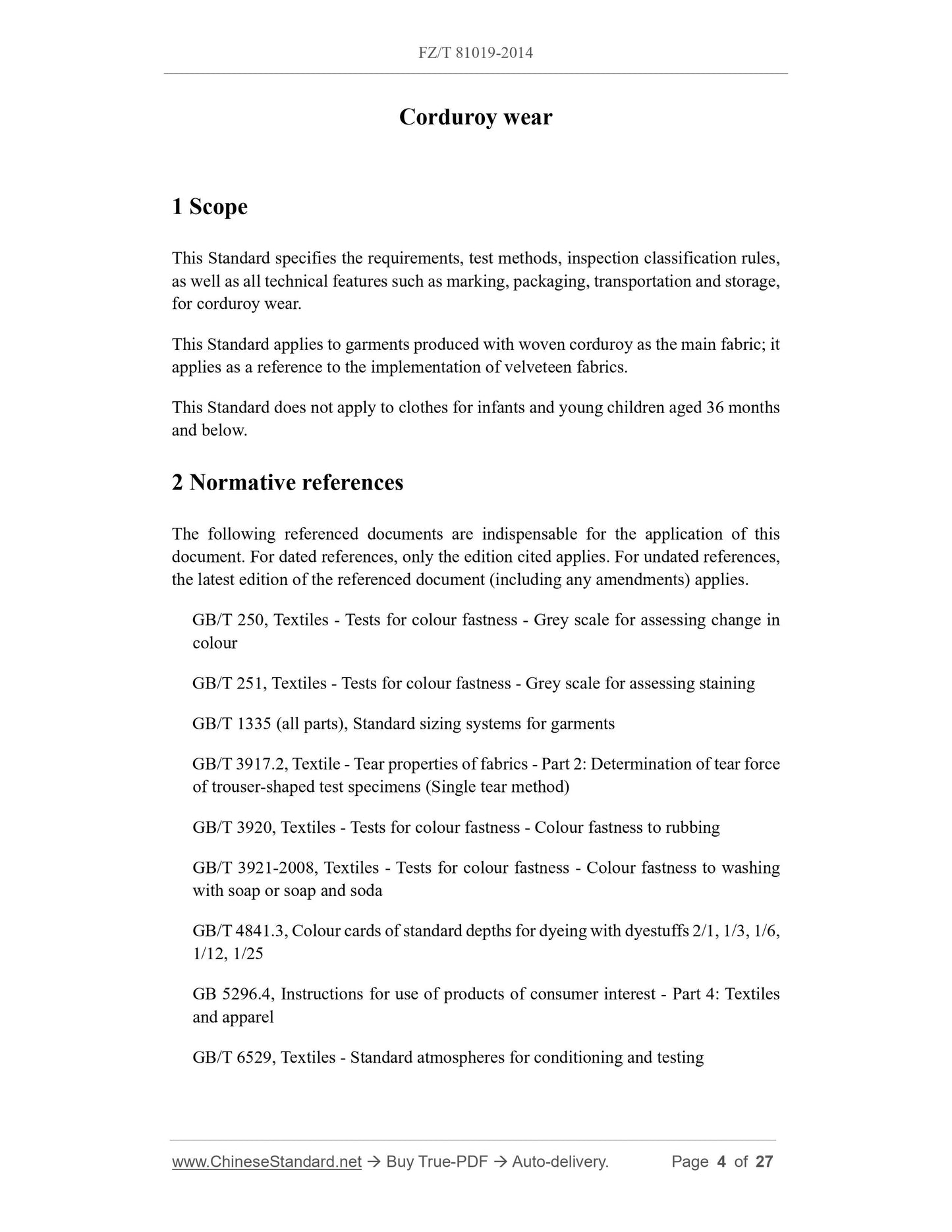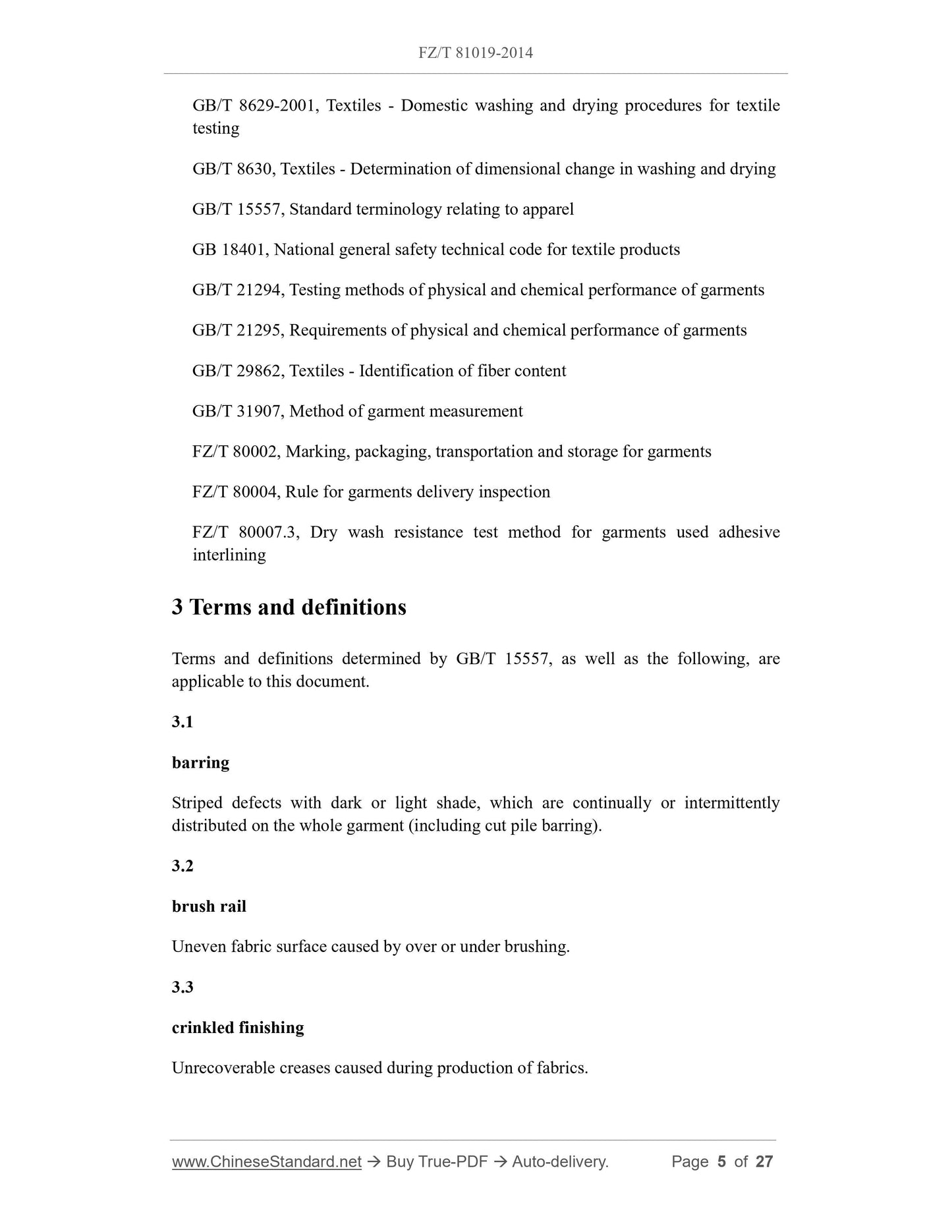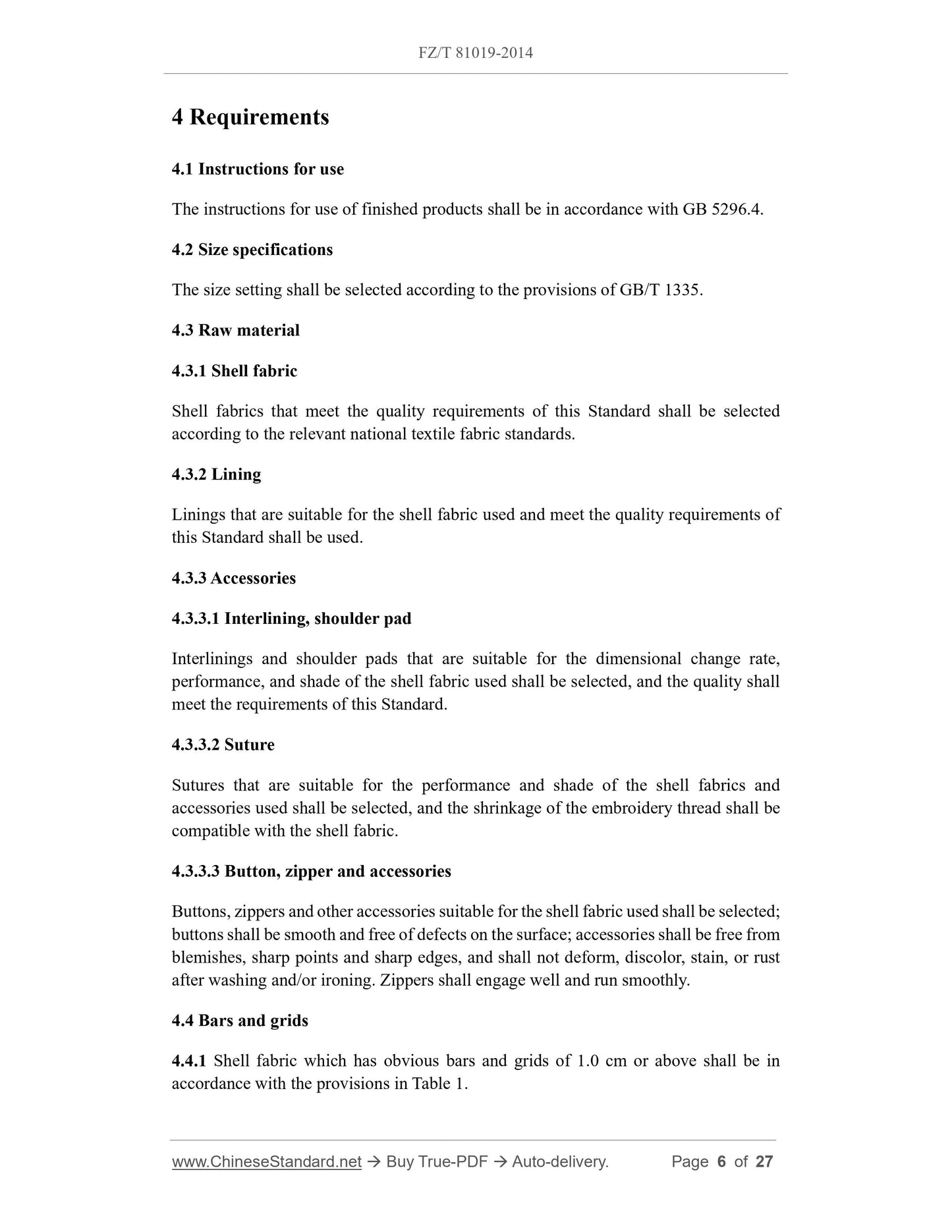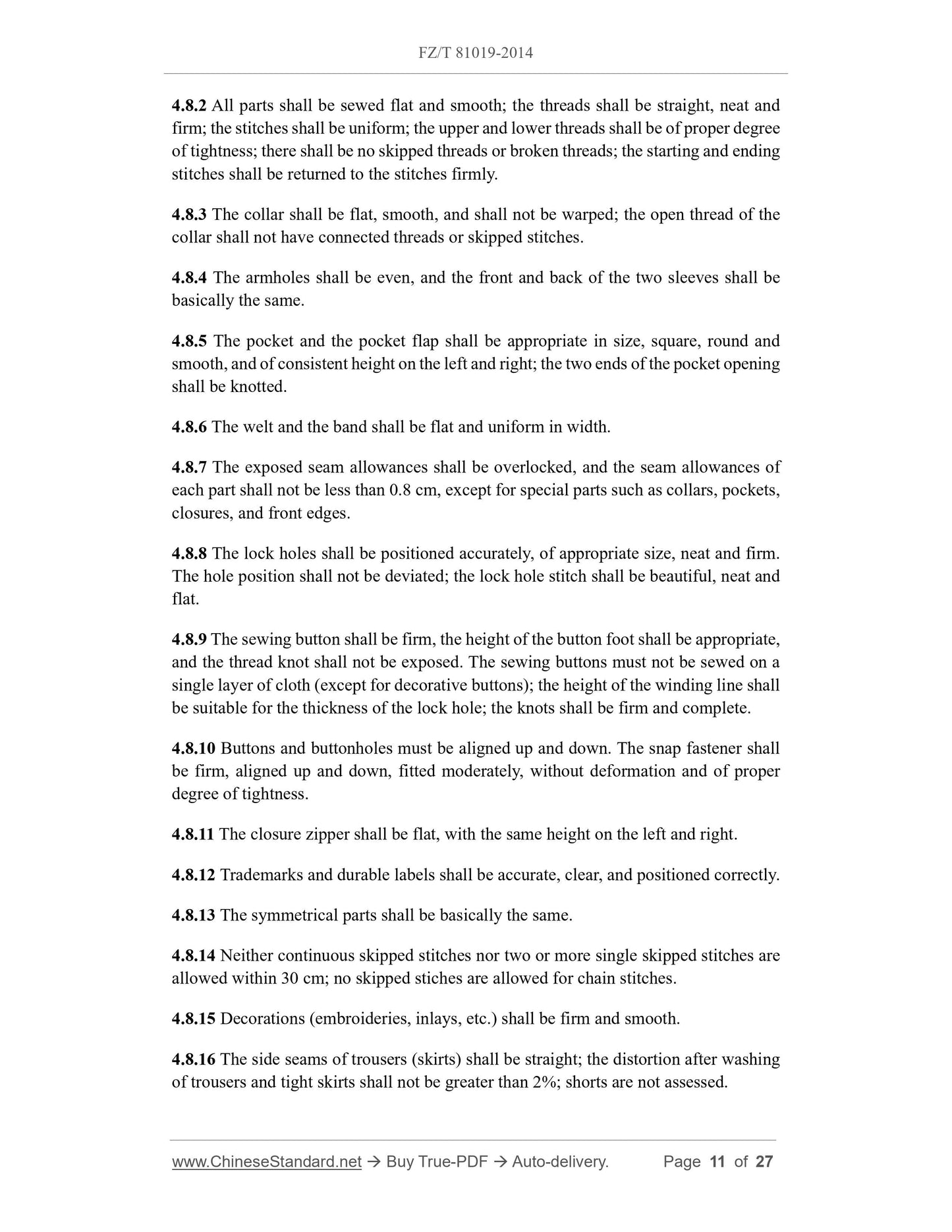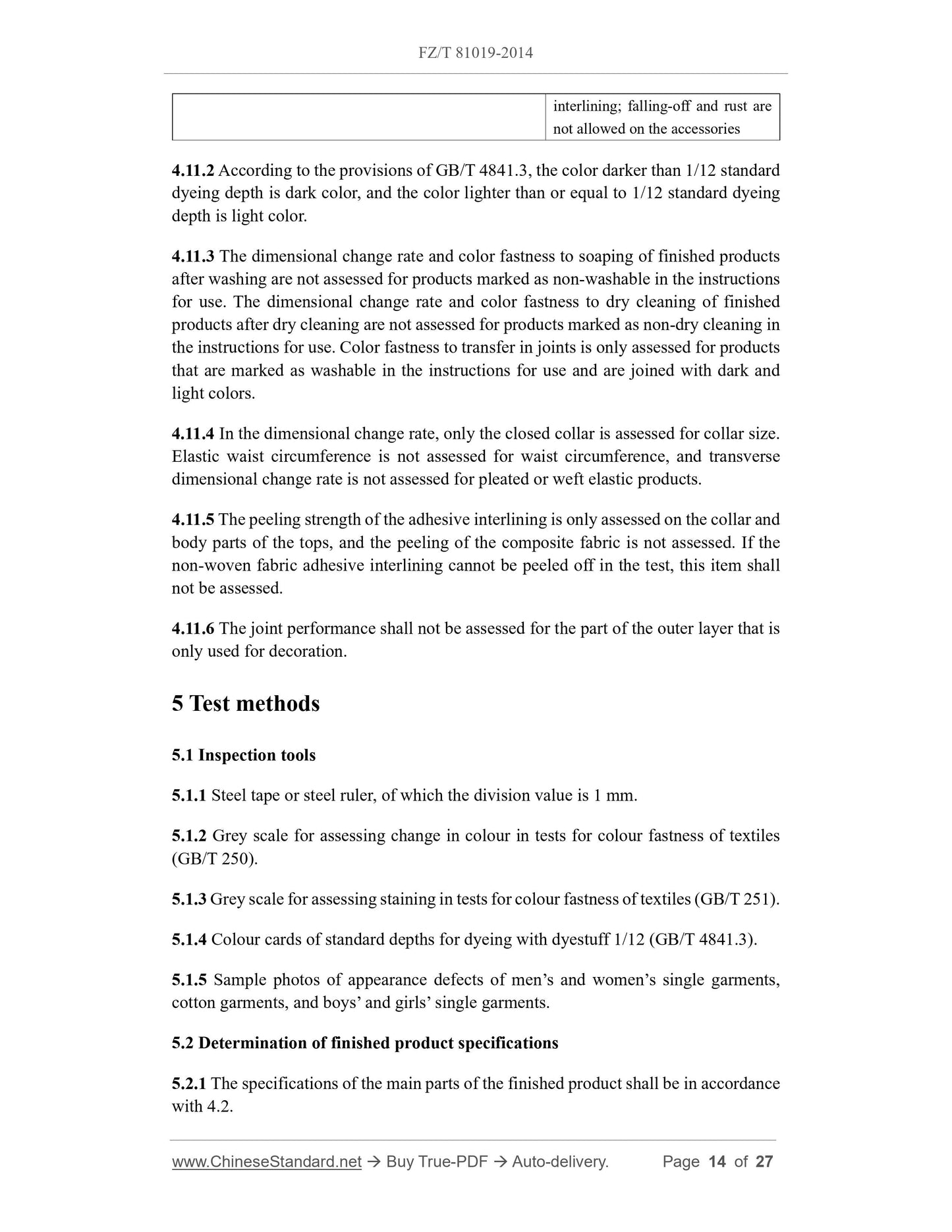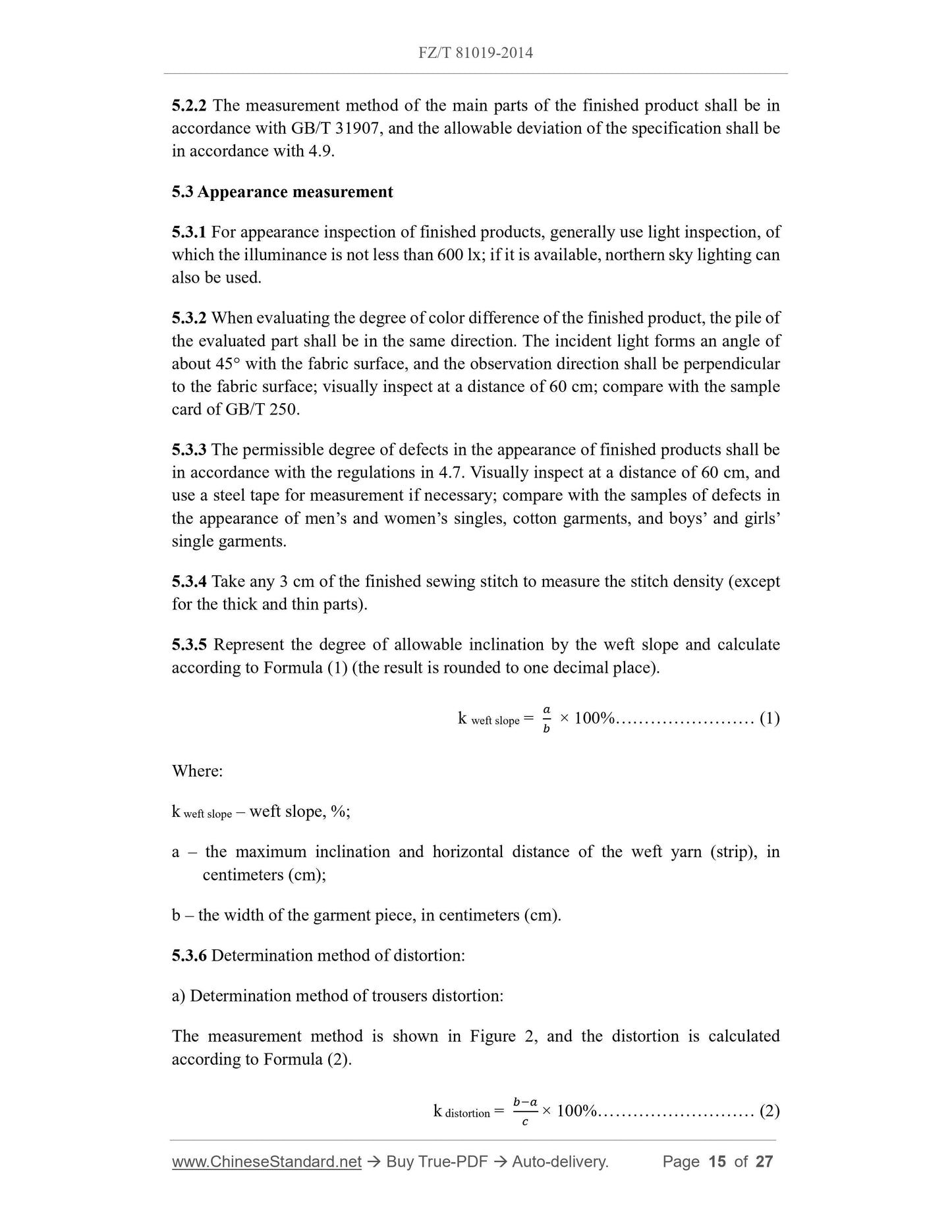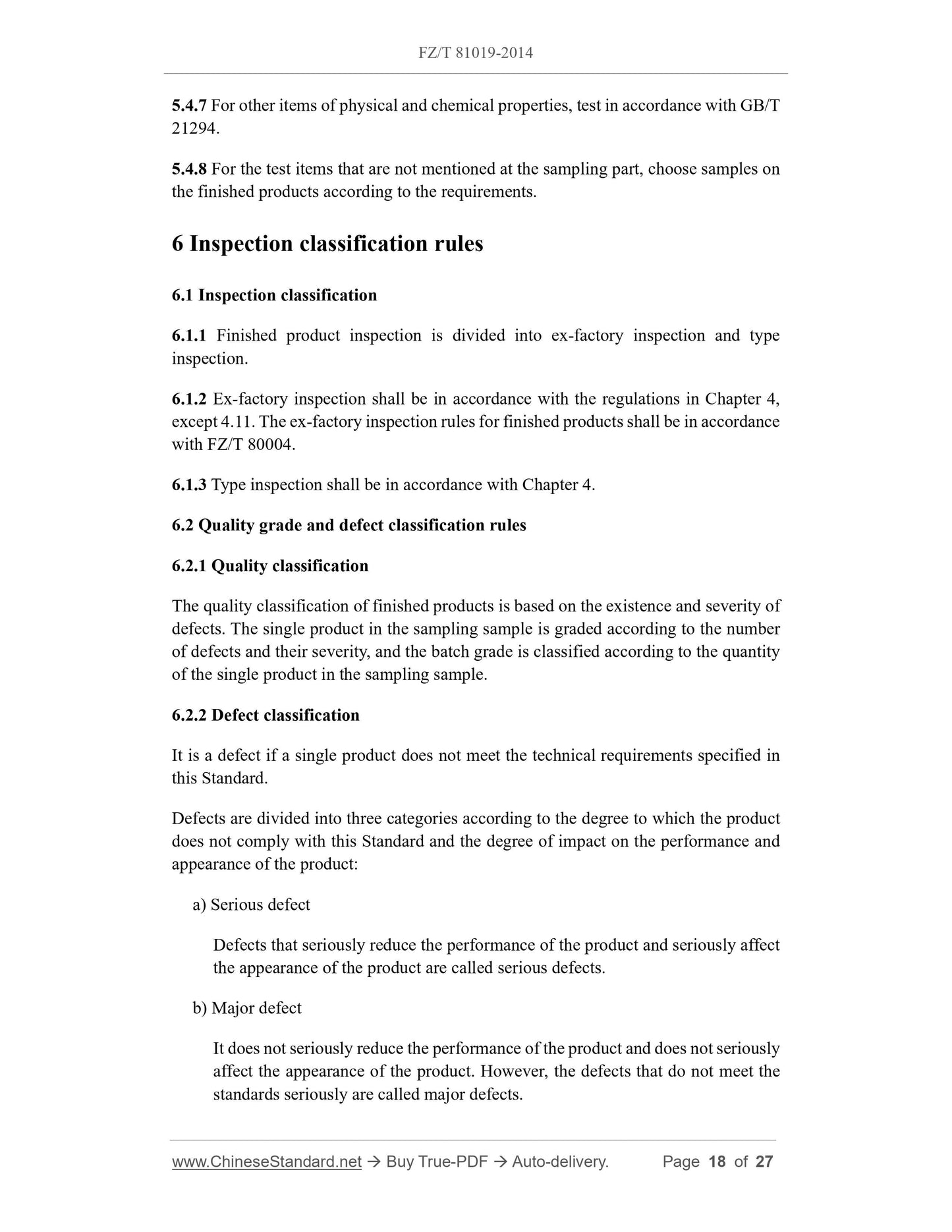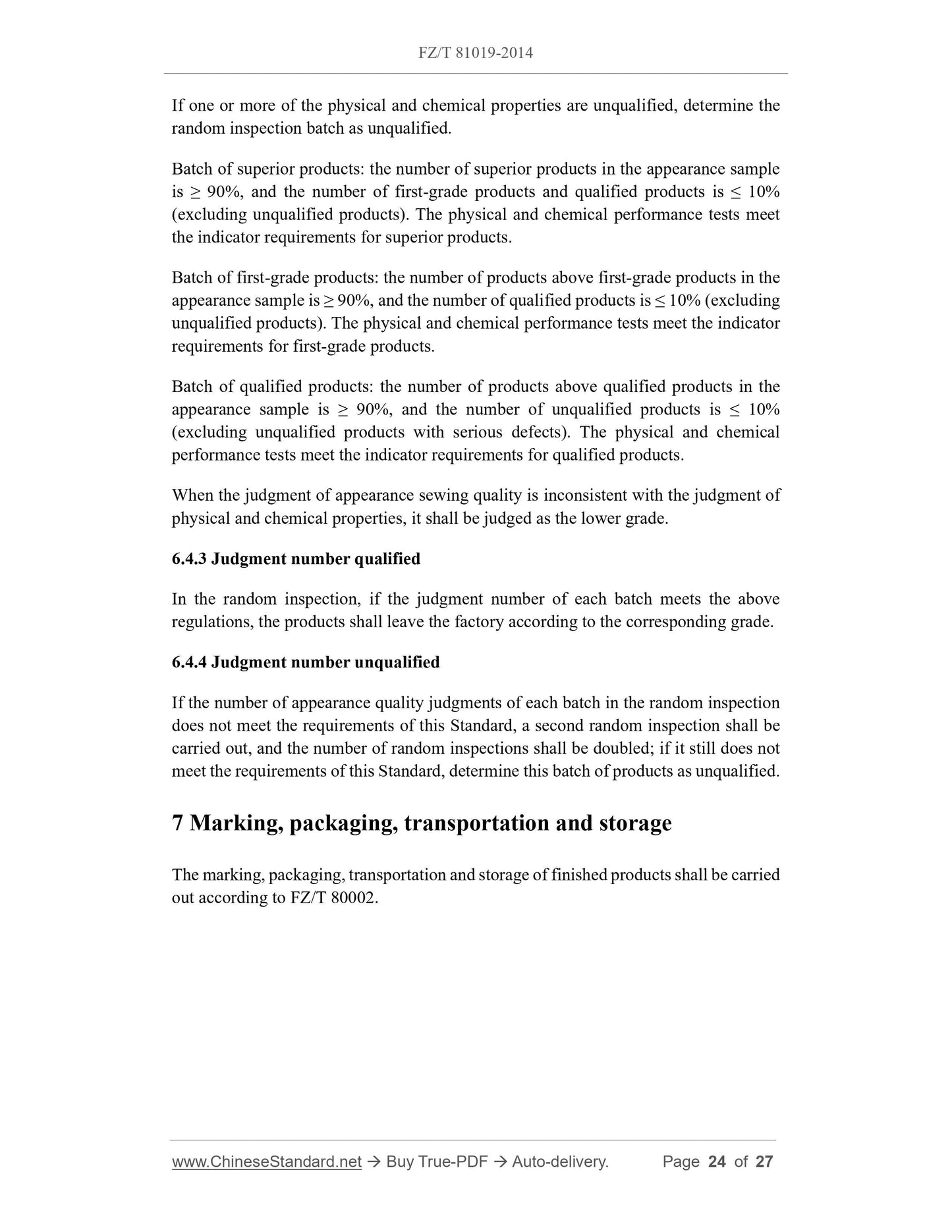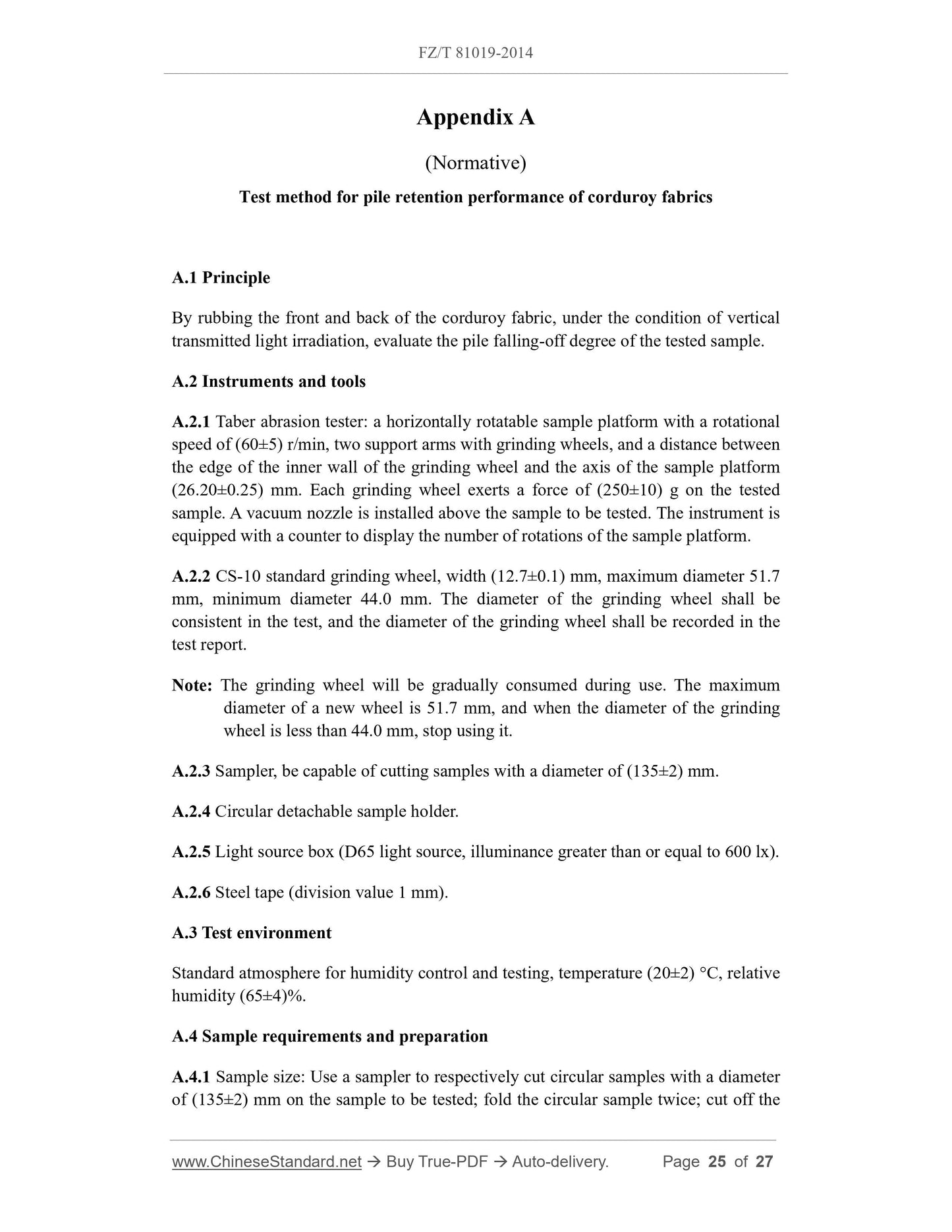PayPal, credit cards. Download editable-PDF and invoice in 1 second!
FZ/T 81019-2014 English PDF (FZT81019-2014)
FZ/T 81019-2014 English PDF (FZT81019-2014)
Precio habitual
$215.00 USD
Precio habitual
Precio de oferta
$215.00 USD
Precio unitario
/
por
Los gastos de envío se calculan en la pantalla de pago.
No se pudo cargar la disponibilidad de retiro
Delivery: 3 seconds. Download true-PDF + Invoice.
Get QUOTATION in 1-minute: Click FZ/T 81019-2014
Historical versions: FZ/T 81019-2014
Preview True-PDF (Reload/Scroll if blank)
FZ/T 81019-2014: Corduroy wear
FZ/T 81019-2014
FZ
TEXTILE INDUSTRY STANDARD OF
THE PEOPLE’S REPUBLIC OF CHINA
ICS 61.020
Y 76
Corduroy wear
灯芯绒服装
ISSUED ON: OCTOBER 14, 2014
IMPLEMENTED ON: APRIL 01, 2015
Issued by: Ministry of Industry and Information Technology of the People’s
Republic of China
Table of Contents
Foreword ... 3
1 Scope ... 4
2 Normative references ... 4
3 Terms and definitions ... 5
4 Requirements ... 6
5 Test methods ... 14
6 Inspection classification rules ... 18
7 Marking, packaging, transportation and storage ... 24
Appendix A (Normative) Test method for pile retention performance of corduroy
fabrics ... 25
Corduroy wear
1 Scope
This Standard specifies the requirements, test methods, inspection classification rules,
as well as all technical features such as marking, packaging, transportation and storage,
for corduroy wear.
This Standard applies to garments produced with woven corduroy as the main fabric; it
applies as a reference to the implementation of velveteen fabrics.
This Standard does not apply to clothes for infants and young children aged 36 months
and below.
2 Normative references
The following referenced documents are indispensable for the application of this
document. For dated references, only the edition cited applies. For undated references,
the latest edition of the referenced document (including any amendments) applies.
GB/T 250, Textiles - Tests for colour fastness - Grey scale for assessing change in
colour
GB/T 251, Textiles - Tests for colour fastness - Grey scale for assessing staining
GB/T 1335 (all parts), Standard sizing systems for garments
GB/T 3917.2, Textile - Tear properties of fabrics - Part 2: Determination of tear force
of trouser-shaped test specimens (Single tear method)
GB/T 3920, Textiles - Tests for colour fastness - Colour fastness to rubbing
GB/T 3921-2008, Textiles - Tests for colour fastness - Colour fastness to washing
with soap or soap and soda
GB/T 4841.3, Colour cards of standard depths for dyeing with dyestuffs 2/1, 1/3, 1/6,
1/12, 1/25
GB 5296.4, Instructions for use of products of consumer interest - Part 4: Textiles
and apparel
GB/T 6529, Textiles - Standard atmospheres for conditioning and testing
GB/T 8629-2001, Textiles - Domestic washing and drying procedures for textile
testing
GB/T 8630, Textiles - Determination of dimensional change in washing and drying
GB/T 15557, Standard terminology relating to apparel
GB 18401, National general safety technical code for textile products
GB/T 21294, Testing methods of physical and chemical performance of garments
GB/T 21295, Requirements of physical and chemical performance of garments
GB/T 29862, Textiles - Identification of fiber content
GB/T 31907, Method of garment measurement
FZ/T 80002, Marking, packaging, transportation and storage for garments
FZ/T 80004, Rule for garments delivery inspection
FZ/T 80007.3, Dry wash resistance test method for garments used adhesive
interlining
3 Terms and definitions
Terms and definitions determined by GB/T 15557, as well as the following, are
applicable to this document.
3.1
barring
Striped defects with dark or light shade, which are continually or intermittently
distributed on the whole garment (including cut pile barring).
3.2
brush rail
Uneven fabric surface caused by over or under brushing.
3.3
crinkled finishing
Unrecoverable creases caused during production of fabrics.
4 Requirements
4.1 Instructions for use
The instructions for use of finished products shall be in accordance with GB 5296.4.
4.2 Size specifications
The size setting shall be selected according to the provisions of GB/T 1335.
4.3 Raw material
4.3.1 Shell fabric
Shell fabrics that meet the quality requirements of this Standard shall be selected
according to the relevant national textile fabric standards.
4.3.2 Lining
Linings that are suitable for the shell fabric used and meet the quality requirements of
this Standard shall be used.
4.3.3 Accessories
4.3.3.1 Interlining, shoulder pad
Interlinings and shoulder pads that are suitable for the dimensional change rate,
performance, and shade of the shell fabric used shall be selected, and the quality shall
meet the requirements of this Standard.
4.3.3.2 Suture
Sutures that are suitable for the performance and shade of the shell fabrics and
accessories used shall be selected, and the shrinkage of the embroidery thread shall be
compatible with the shell fabric.
4.3.3.3 Button, zipper and accessories
Buttons, zippers and other accessories suitable for the shell fabric used shall be selected;
buttons shall be smooth and free of defects on the surface; accessories shall be free from
blemishes, sharp points and sharp edges, and shall not deform, discolor, stain, or rust
after washing and/or ironing. Zippers shall engage well and run smoothly.
4.4 Bars and grids
4.4.1 Shell fabric which has obvious bars and grids of 1.0 cm or above shall be in
accordance with the provisions in Table 1.
4.8.2 All parts shall be sewed flat and smooth; the threads shall be straight, neat and
firm; the stitches shall be uniform; the upper and lower threads shall be of proper degree
of tightness; there shall be no skipped threads or broken threads; the starting and ending
stitches shall be returned to the stitches firmly.
4.8.3 The collar shall be flat, smooth, and shall not be warped; the open thread of the
collar shall not have connected threads or skipped stitches.
4.8.4 The armholes shall be even, and the front and back of the two sleeves shall be
basically the same.
4.8.5 The pocket and the pocket flap shall be appropriate in size, square, round and
smooth, and of consistent height on the left and right; the two ends of the pocket opening
shall be knotted.
4.8.6 The welt and the band shall be flat and uniform in width.
4.8.7 The exposed seam allowances shall be overlocked, and the seam allowances of
each part shall not be less than 0.8 cm, except for special parts such as collars, pockets,
closures, and front edges.
4.8.8 The lock holes shall be positioned accurately, of appropriate size, neat and firm.
The hole position shall not be deviated; the lock hole stitch shall be beautiful, neat and
flat.
4.8.9 The sewing button shall be firm, the height of the button foot shall be appropriate,
and the thread knot shall not be exposed. The sewing buttons must not be sewed on a
single layer of cloth (except for decorative buttons); the height of the winding line shall
be suitable for the thickness of the lock hole; the knots shall be firm and complete.
4.8.10 Buttons and buttonholes must be aligned up and down. The snap fastener shall
be firm, aligned up and down, fitted moderately, without deformation and of proper
degree of tightness.
4.8.11 The closure zipper shall be flat, with the same height on the left and right.
4.8.12 Trademarks and durable labels shall be accurate, clear, and positioned correctly.
4.8.13 The symmetrical parts shall be basically the same.
4.8.14 Neither continuous skipped stitches nor two or more single skipped stitches are
allowed within 30 cm; no skipped stiches are allowed for chain stitches.
4.8.15 Decorations (embroideries, inlays, etc.) shall be firm and smooth.
4.8.16 The side seams of trousers (skirts) shall be straight; the distortion after washing
of trousers and tight skirts shall not be greater than 2%; shorts are not assessed.
Get QUOTATION in 1-minute: Click FZ/T 81019-2014
Historical versions: FZ/T 81019-2014
Preview True-PDF (Reload/Scroll if blank)
FZ/T 81019-2014: Corduroy wear
FZ/T 81019-2014
FZ
TEXTILE INDUSTRY STANDARD OF
THE PEOPLE’S REPUBLIC OF CHINA
ICS 61.020
Y 76
Corduroy wear
灯芯绒服装
ISSUED ON: OCTOBER 14, 2014
IMPLEMENTED ON: APRIL 01, 2015
Issued by: Ministry of Industry and Information Technology of the People’s
Republic of China
Table of Contents
Foreword ... 3
1 Scope ... 4
2 Normative references ... 4
3 Terms and definitions ... 5
4 Requirements ... 6
5 Test methods ... 14
6 Inspection classification rules ... 18
7 Marking, packaging, transportation and storage ... 24
Appendix A (Normative) Test method for pile retention performance of corduroy
fabrics ... 25
Corduroy wear
1 Scope
This Standard specifies the requirements, test methods, inspection classification rules,
as well as all technical features such as marking, packaging, transportation and storage,
for corduroy wear.
This Standard applies to garments produced with woven corduroy as the main fabric; it
applies as a reference to the implementation of velveteen fabrics.
This Standard does not apply to clothes for infants and young children aged 36 months
and below.
2 Normative references
The following referenced documents are indispensable for the application of this
document. For dated references, only the edition cited applies. For undated references,
the latest edition of the referenced document (including any amendments) applies.
GB/T 250, Textiles - Tests for colour fastness - Grey scale for assessing change in
colour
GB/T 251, Textiles - Tests for colour fastness - Grey scale for assessing staining
GB/T 1335 (all parts), Standard sizing systems for garments
GB/T 3917.2, Textile - Tear properties of fabrics - Part 2: Determination of tear force
of trouser-shaped test specimens (Single tear method)
GB/T 3920, Textiles - Tests for colour fastness - Colour fastness to rubbing
GB/T 3921-2008, Textiles - Tests for colour fastness - Colour fastness to washing
with soap or soap and soda
GB/T 4841.3, Colour cards of standard depths for dyeing with dyestuffs 2/1, 1/3, 1/6,
1/12, 1/25
GB 5296.4, Instructions for use of products of consumer interest - Part 4: Textiles
and apparel
GB/T 6529, Textiles - Standard atmospheres for conditioning and testing
GB/T 8629-2001, Textiles - Domestic washing and drying procedures for textile
testing
GB/T 8630, Textiles - Determination of dimensional change in washing and drying
GB/T 15557, Standard terminology relating to apparel
GB 18401, National general safety technical code for textile products
GB/T 21294, Testing methods of physical and chemical performance of garments
GB/T 21295, Requirements of physical and chemical performance of garments
GB/T 29862, Textiles - Identification of fiber content
GB/T 31907, Method of garment measurement
FZ/T 80002, Marking, packaging, transportation and storage for garments
FZ/T 80004, Rule for garments delivery inspection
FZ/T 80007.3, Dry wash resistance test method for garments used adhesive
interlining
3 Terms and definitions
Terms and definitions determined by GB/T 15557, as well as the following, are
applicable to this document.
3.1
barring
Striped defects with dark or light shade, which are continually or intermittently
distributed on the whole garment (including cut pile barring).
3.2
brush rail
Uneven fabric surface caused by over or under brushing.
3.3
crinkled finishing
Unrecoverable creases caused during production of fabrics.
4 Requirements
4.1 Instructions for use
The instructions for use of finished products shall be in accordance with GB 5296.4.
4.2 Size specifications
The size setting shall be selected according to the provisions of GB/T 1335.
4.3 Raw material
4.3.1 Shell fabric
Shell fabrics that meet the quality requirements of this Standard shall be selected
according to the relevant national textile fabric standards.
4.3.2 Lining
Linings that are suitable for the shell fabric used and meet the quality requirements of
this Standard shall be used.
4.3.3 Accessories
4.3.3.1 Interlining, shoulder pad
Interlinings and shoulder pads that are suitable for the dimensional change rate,
performance, and shade of the shell fabric used shall be selected, and the quality shall
meet the requirements of this Standard.
4.3.3.2 Suture
Sutures that are suitable for the performance and shade of the shell fabrics and
accessories used shall be selected, and the shrinkage of the embroidery thread shall be
compatible with the shell fabric.
4.3.3.3 Button, zipper and accessories
Buttons, zippers and other accessories suitable for the shell fabric used shall be selected;
buttons shall be smooth and free of defects on the surface; accessories shall be free from
blemishes, sharp points and sharp edges, and shall not deform, discolor, stain, or rust
after washing and/or ironing. Zippers shall engage well and run smoothly.
4.4 Bars and grids
4.4.1 Shell fabric which has obvious bars and grids of 1.0 cm or above shall be in
accordance with the provisions in Table 1.
4.8.2 All parts shall be sewed flat and smooth; the threads shall be straight, neat and
firm; the stitches shall be uniform; the upper and lower threads shall be of proper degree
of tightness; there shall be no skipped threads or broken threads; the starting and ending
stitches shall be returned to the stitches firmly.
4.8.3 The collar shall be flat, smooth, and shall not be warped; the open thread of the
collar shall not have connected threads or skipped stitches.
4.8.4 The armholes shall be even, and the front and back of the two sleeves shall be
basically the same.
4.8.5 The pocket and the pocket flap shall be appropriate in size, square, round and
smooth, and of consistent height on the left and right; the two ends of the pocket opening
shall be knotted.
4.8.6 The welt and the band shall be flat and uniform in width.
4.8.7 The exposed seam allowances shall be overlocked, and the seam allowances of
each part shall not be less than 0.8 cm, except for special parts such as collars, pockets,
closures, and front edges.
4.8.8 The lock holes shall be positioned accurately, of appropriate size, neat and firm.
The hole position shall not be deviated; the lock hole stitch shall be beautiful, neat and
flat.
4.8.9 The sewing button shall be firm, the height of the button foot shall be appropriate,
and the thread knot shall not be exposed. The sewing buttons must not be sewed on a
single layer of cloth (except for decorative buttons); the height of the winding line shall
be suitable for the thickness of the lock hole; the knots shall be firm and complete.
4.8.10 Buttons and buttonholes must be aligned up and down. The snap fastener shall
be firm, aligned up and down, fitted moderately, without deformation and of proper
degree of tightness.
4.8.11 The closure zipper shall be flat, with the same height on the left and right.
4.8.12 Trademarks and durable labels shall be accurate, clear, and positioned correctly.
4.8.13 The symmetrical parts shall be basically the same.
4.8.14 Neither continuous skipped stitches nor two or more single skipped stitches are
allowed within 30 cm; no skipped stiches are allowed for chain stitches.
4.8.15 Decorations (embroideries, inlays, etc.) shall be firm and smooth.
4.8.16 The side seams of trousers (skirts) shall be straight; the distortion after washing
of trousers and tight skirts shall not be greater than 2%; shorts are not assessed.
Share
